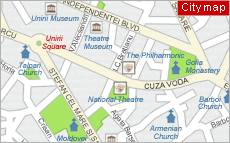 |
Iasi - General Information
Location: Eastern Romania (Iasi county)
Size: 37 sq. miles (96 sq. kilometers)
Elevation: 312 ft. (105 meters)
Population: 350,000
Inhabited since: 400 BC
First documented: 1387 AD
Location: Eastern Romania (Iasi county)
Size: 37 sq. miles (96 sq. kilometers)
Elevation: 312 ft. (105 meters)
Population: 350,000
Inhabited since: 400 BC
First documented: 1387 AD
IASI - City Highlights
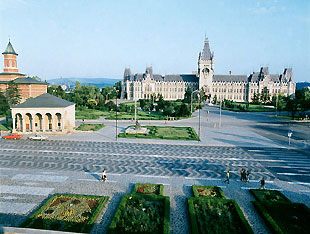 Iasi is the most important political, economic and cultural centre of the province of Moldavia as well as one of the oldest cities in Romania. Located in the northeastern part of the country, Iasi was for many centuries the crossing point of the most important commercial routes linking Poland, Hungary, Russia and Constantinople. Deeply rooted in history, Iasi has been the main centre of Moldavian culture since 1408. The city prides itself with publishing the first Romanian newspaper and establishing the first Romanian university. Today, Iasi is home to five universities.
Iasi is the most important political, economic and cultural centre of the province of Moldavia as well as one of the oldest cities in Romania. Located in the northeastern part of the country, Iasi was for many centuries the crossing point of the most important commercial routes linking Poland, Hungary, Russia and Constantinople. Deeply rooted in history, Iasi has been the main centre of Moldavian culture since 1408. The city prides itself with publishing the first Romanian newspaper and establishing the first Romanian university. Today, Iasi is home to five universities. Over the past 500 years, history, culture and religious life have molded the city's unique character. Iasi boasts an impressive number of Orthodox churches, almost 100, most of them located in the so-called Golden Plateau (Platoul de Aur). The oldest, the Princely Saint Nicholas Church, dates from the reign of Stephen the Great (Stefan cel Mare, 1457-1504). The finest, however, are the 17th century St. Paraschiva Metropolitan Cathedral and Trei Ierarhi Church, the last a curious example of Byzantine art, erected in 1635-1639 by Vasile Lupu. Its outer walls and twin towers are intricately carved in what many think of as stone lace.
Iasi is among the very few cities in the Orthodox world with more than 100 churches.
In 1565, Iasi became the capital of Moldavia and for a short period of time, from 1859 until 1862, the capital of Romania.
The Golden Plateau represents the nucleus of the city, around which the entire settlement developed over the centuries. With the Palace of Culture at one end and theUnion Square (Piata Unirii) at the other, the Golden Plateau features churches and princely palaces on both sides of Stefan cel Mare si Sfant Boulevard, which runs right through its centre. Many other important sites can be found on nearby streets. In 1565, Iasi became the capital of Moldavia and for a short period of time, from 1859 until 1862, the capital of Romania.
» City Landmarks
Palace of Culture (Palatul Culturii)Address: Piata Stefan cel Mare si Sfant 1
Open: Tue. - Sun 10:00am - 5:00pm; closed on Mondays
Free admission (not including museums)
This remarkable construction (1906-1925), built in flamboyant neogothic style, stands partly on the ruins of a medieval royal court mentioned in documents dating from 1434. Today, the 365-room palace houses the Gheorghe Asachi Library and four of the city's museums: the Moldavian History Museum, the Ethnographic Museum, the Museum of Art and the Museum of Science and Technology (see museum details). The interior décor, with the lavish furnishings and magnificent staircase of the entrance lobby, can be admired free of charge, but tickets are required for entry to the museums.
St. Paraschiva Metropolitan Cathedral (Catedrala Mitropolitana Sfanta Paraschiva)
Address: Blvd. Stefan cel Mare si Sfant 46
Open: Mon. - Sun. 9:00am - 8:00pm
Free admission
Built in Italian Renaissance style, the St. Paraschiva Metropolitan Cathedral is the largest Orthodox church in Romania. Construction began in 1833 and ended in 1839, but its cupolas fell and the church remained in ruins until 1880, when, with the help of the Foundation of King Carol I, work started again, lasting until 1888. The vast interior was painted in 1887 by Gheorghe Tattarescu and the stained glass windows were completed by a Bavarian factory in Munich.
In 1639, Vasile Lupu spent Moldavia's budget for the following year and a half to acquire the relics of St. Paraschiva from Constantinopole. The relics were moved to the Metropolitan Cathedral in 1889 after a fire damaged the Trei Ierarchi Church where they had originally been placed.
The cathedral still uses one of the original bells in its northeast spire. Inside the bell, an inscription says it was made from four cannons captured from the Turkish army in the War of 1828-1829. Nearby stands the 18th century Old Metropolitan Church of St. George (Biserica Sfantul Gheorghe).Every October 14, pilgrims from all corners of Romania and neighboring countries flock to Iasi to kneel before the blue and gold bier containing the relics of Saint Paraschiva, the patron saint of the cathedral.
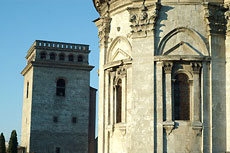 Church of the Three Hierarchs
Church of the Three Hierarchs (Biserica Sfantilor Trei Ierarhi)
Address: Str. Stefan cel Mare 62
Open: Daily 9:00am - 1:00pm & 3:00pm - 7:00pm
Admission charge
The Church of the Three Hierarchs (constructed 1637 - 1639) is highlighted as a must-see in every guidebook. Nothing can prepare you, though, for its stunning ornate decoration: the entire exterior of the church is covered in delicate and intricate patterns sculpted into the stone and spread over 30 friezes. This "stone embroidery" is a mixture of western gothic, Renaissance and Oriental motifs.
Legend has it that the exterior was covered in gold, silver and lapis lazuli but centuries ago, when the Ottoman Empire tried to conquer Moldavia, the invaders sat the church on fire and melted all the gold.
The original interior paintings were completed by Russian artists sent to Iasi by the Tsar. In 1882, the frescoes were removed when French architect Lecomte de Nouy set about redesigning the interior after several fires and six earthquakes damaged the structure. Original fragments of the frescoes are still preserved in the nearby Gothic Hall museum (Open: Tue.-Sun. 10am - 4pm. Admission charge).The interior boasts the tombs of a number of famous Romanians, including the founder of this church, Vasile Lupu, Prince Alexandru Ioan Cuza, and Prince Dimitrie Cantemir. In 1994, the church reopened as a monastery. The three patron saints (Basil the Great, Gregory of Nazianzus and John Crysostom) are celebrated here on January 30.
Roznoveanu Palace/City Hall (Palatul Rozvoneanu/Primaria)
Address: Blvd. Stefan cel Mare si Sfant 45
This neoclassical Viennese-style palace was built in 1832 to the design of Gustav Frey Wald. Its façade was decorated with marble statues of mythological characters such as Diana and Apollo and it was said to be grander than all other mansions in Iasi. The palace burned down in 1844 and was rebuilt by Nicolae Rosetti Rozvaneanu. In 1891, the building became the City Hall but two years later, was transformed into a royal residence. Today, it once again serves as the City Hall.
Alexandru Bals House/ Moldova Philharmonic House (Filarmonica Moldova)
Address: Str. Arcu 13
Built in 1815 by Alexandru Bals, this house became the venue of choice for theatre performances in Iasi. On January 18, 1847, the famous composer, Franz Liszt, played here. In 1868, Monsignor Salandarie founded the Catholic Institute here, enlarging the building and adding a spacious extension, which today, houses the Moldavia Philharmonic. The old building is home to the George Enescu Conservatoire.
National Theatre (Teatrul National Vasile Alecsandri)
Address: Str. Agatha Barsescu 18
Built in the late 19th century on the site of the old City Hall, this is one of the most elegant buildings in Romania. The architects were the Viennese Feller and Helmer who later built theatres in Cernauti and Sofia. Richly decorated in French-eclectic style, the theatre has one of the most splendid auditoriums in the country. It can seat 1,000 people and the acoustics are excellent. The theatre bears the name of the company's founder, Vasile Alecsandri (1821-1890), a renowned Romanian poet, playwright, politician and diplomat.
In 1934, Greta Garbo spent some time here in secret during her love affair with John Gilbert.
Traian Hotel (Hotelul Traian)Address: Piata Unirii 1
Built in neoclassical style in 1879 by an engineer, G. Fragneau, who worked with G. Eiffel & Co. in Paris (yes, the Eiffel who designed the Eiffel Tower), the hotel was one of the first in Europe to be molded on a metal frame. Throughout the years, many foreign diplomats and other personalities have stayed at the Traian.
Ticau District (Cartierul Ticau)
Address: Opposite Copou Park
Fans of quaint streets will enjoy this old residential quarter spread out over the hilly side of Iasi, with vine-choked houses and sleepy roads. Stroll along the peaceful Dimitrie Ralet, Lascar Catargiu and Vasile Conta Streets to reach Piata Mihai Eminescu. From there, take the scenic route along Strada Lapusneanu, Piata Unirii and Strada Cuza Voda.
Iasi - cultural breeding ground
The beginnings of higher education in Iasi date from the reign of Vasile Lupu (1634-1653). In 1640, Lupu founded an academy at the Three Hierarchs Monastery.In the 18th century, a Royal Academy was established in one of the buildings attached to the Metropolitan Cathedral. The institution was closed down by the Ottomans after the Greek Revolution of 1821, but Gheorghe Asachi reopened it under the name of The Vasilian Gymnasium seven years later. In 1835, it was renamed The Mihailean Academy and had three sections: Philosophy, Law and Theology, as well as two special courses, Polytechnic Sciences and Economy.
In 1860, Alexander Ioan Cuza founded the University of Iasi. Today, this university is comprised of 26 colleges and eight research institutes of the Romanian Academy.
Old University Palace (Vechea Universitate)
Address: Blvd. Independentei 35
Commissioned by Ioan Cantacuzino between 1760 and 1765, the Old University Palace was badly damaged during a fire in 1795. Later renovated and converted into a royal residence, it remained in royal use until 1806. The stone arch in front of the palace dates from this period. On it, you can see the Moldavian coat of arms and a Cyrillic inscription spelling out the words the door of hope. In 1860, the building became home to the newly established University of Iasi and to the first public art collection in the country. Today, it houses the Medicine and Pharmacy College.
University on Copou Hill (Universitatea Alexandru Ioan Cuza)
Address: Blvd. Carol I nr. 11
The main university building was built between 1893 and 1897 on the site of the Great Theatre which had burned down. The Hall of the University, known as The Hall of the Lost Footsteps, served as a parliamentary debating chamber between 1917 and 1918. In 1967, the painter Sabin Balasa created a series of strongly romanticized frescoes for the arcades.
Central University Library (Biblioteca Centrala Universitara Mihai Eminescu)
Address: Str. Pacurari 4
Located at the base of Copou Hill, this triangular building with Doric columns and cupola was built between 1930 and 1935 to serve as the headquarters of King Ferdinand's Cultural Foundation. The building was decorated with Carrara marble and Venetian mosaics. By 1945, the Foundation library had become one of the biggest in the country with more than 300,000 volumes. Today, the library is the largest in Moldavia, with a great number of manuscripts and old books from the 15th to the 19th centuries.
Historic Churches
Golia Monastery (Manastirea Golia)Address: Str. Cuza Voda 51
Open: daily from sunrise to sunset
Free admission
The unusual name of the monastery came from Moldavian Chancellor Ioan Golai who founded it in 1564. The church was rebuilt in 1650 by Vasile Lupu who employed Italian master craftsmen. The compound's walls and towers were added in 1667.
While the exterior walls show Renaissance influence, mainly with their Corinthian pilasters, the interior features vibrant Byzantine frescoes and intricately carved doorways. The upper part of the church seems to belong to another edifice. It was built during the rein of Stefanita Lupu, son of Vasile Lupu, who found inspiration in Russian architecture. However, this section collapsed during a 1738 earthquake and was rebuilt in baroque style by the Phanariot ruler, Constantin Mavrocordat.
The monastery was visited by Peter the Great, Tsar of Russia, in 1711. It also served for a short period of time as the burial place for the viscera of Prince Grigori Alexandrovich Potemkin, Catherine the Great's favorite. Climbing the 102 steps to the monastery's "Golia Tower" offers visitors a magnificent bird's-eye view of the city.
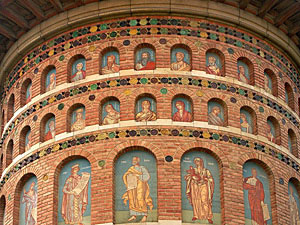 The Princely Saint Nicholas Church
The Princely Saint Nicholas Church(Biserica Sfantul Nicolae Domnesc)
Address: Str. Anastasie Panu 65, Iasi
Open: daily 8am to sunset
Free admission
The oldest church in Iasi, Saint Nicholas Church was founded by Stefan cel Mare in 1492. Situated near the princely court, the church was for centuries the place where Moldavian rulers were anointed, therefore, gaining its "royal" status. Restored by Prince Antonie Roset in 1677, it was completely renovated by the French architect Andre Lecomte du Nouy between 1885 and 1897.
Jewish Iasi
In the 19th century, Iasi was one of the great Eastern European centres of Jewish learning, famous for its scholarly rabbis, intellectuals and skilled craftsmen, as well as for its Jewish schools, hospitals, publications and other organizations.In 1855, the city was the home of the first-ever Yiddish-language newspaper, Korot Haitim, and was the birthplace of the Israeli national anthem. The world's first professional Yiddish-language theatre was opened here in 1876 by Avram Goldfaden, who later founded New York's first Jewish theatre. From 1949 to 1964, Iasi was also home to a second company of the State Jewish Theatre.
Jewish merchants from Poland settled here in the 15th century and their numbers swelled with further waves of Russian-Jewish and Galician-Jewish immigration into Moldavia. By 1930, there were over 30,000 Jews and some 127 synagogues. Today, only two synagogues remain open.
During the early years of World War II, Iasi was the scene of a pogrom by the Iron Guard, a nationalist Fascist organization. The majority of the city's Jewish population was killed or deported. A monument to the victims of the 1941 pogrom was erected outside the Great Synagogue.
The Great Synagogue (Sinagoga Mare)
Address: Str. Sinagogilor 7
The Great Synagogue of Iasi is the oldest surviving Jewish prayer house in Romania and the second oldest synagogue in Europe. It was founded in 1670, reportedly at the initiative of Rabbi Nathan (Nata) ben Moses Hannover, religious leader of Iasi's Jewish community in the 1660s and author of Yeven. Mezullah. Located on Synagogues Street (so dubbed because of the many synagogues once found here) in the old Jewish neighborhood of Targu Cucului, the synagogue was built in an eclectic style with strong late baroque influences. Since its foundation in the second half of the 17th century, the Great Synagogue has undergone a number of major renovations.
Although called "the great," the size of the synagogue is actually very modest. The floor is located below street level in keeping with a widespread tradition found in many Central and Eastern European synagogues. Jewish religious tradition requires that synagogues should be the highest buildings in their neighborhoods but because Jews were not permitted to build high structures for their prayer houses, lowering the floor of synagogues represented an ingenious compromise between the two demands by creating an interior that is higher than the exterior elevation of the building. It also serves as a reminder of Psalm 130 ("de profundis"): "Out of the depths have I cried unto Thee, o Lord".
Today, the Great Synagogue continues to serve the Jewish community of Iasi. It has been recognized as a historical monument.
The Iasi Jewish Cemetery
Address: Sos. Pacurari (bus and trolleybus connections from Piata Eminescu)
Open daily
Admission charge
Many of the victims of the 1941 pogroms were buried in the Jewish Cemetery, located outside the city on Dealul Munteni (Mountain Hill). Over 100,000 graves, some dating from the late 1800s, stretch across the hillside; burial records date from 1915 to the present day and are kept in the community centre. The second, smaller synagogue is also located here.
Jewish Community of Iasi (Comunitatea Evreiasca din Iasi)
Address: Str. Elena Doamna 15
Tel: (232) 313.711
» Museums
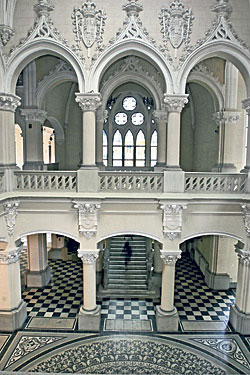 Museum of Moldova
Museum of Moldova(Complexul Muzeal National Moldova)
Address: Piata Stefan cel Mare si Sfant 1
(housed in the Palace of Culture / Palatul Culturii)
Tel: (232) 218.383
Email: contact@muzeul-moldova.ro
Web: www.muzeul-moldova.ro
Open: Tue. - Sun. 10:00am - 5:00pm;
closed on Mon.
Admission charge (tickets may be purchased
for one or all four museums)
1. Moldavian Ethnographic Museum
(Muzeul Etnografic al Moldovei)
The Moldavian Ethnographic Museum is one of the oldest and largest in the country. Encompassing 16 rooms, the displays cover every aspect of traditional Moldavian life, featuring agricultural and hunting tools, woodwork, traditional pottery, painted eggs and a good collection of textiles and dyed carpets embroidered with bird and plant motifs. One room exhibits winter customs items, including masks representing the bear, the goat and other characters of traditional New Year's festivities. The collection of wooden machinery is impressive with 19th century tree-size oil and wine presses.
2. Art Museum (Muzeul de Arta)
The art collection began with a set of oil paintings purchased at a Parisian auction in 1845. The official opening took place in 1860 at the Old University Palace and in 1955, the museum moved to its current location in the Palace of Culture. An excellent collection of Romanian paintings from the 19th and 20th centuries vividly illustrates Moldavian rural life and its landscape. Nicolae Grigorescu's Car cu Boi (Ox Cart), Theodor Amann's Hora de peste Olt (The Village Dance) and O. Bancila's Batran Croitor (Old Jewish Tailor) are some of the collection's highlights.
In the four rooms devoted to European art, there are paintings by Murillo, Philippe de Champaigne, Paolo Veronese and a Rubens, Cezar Receiving Pompey's Head. Additionally, you'll find works by foreign artists who lived and worked in Iasi such as Schiavonim Livaditii and Stavscki.
The sculpture collection includes pieces by national artists such as Oscar Han, Cornel Medrea, Ion Jalea and Ion Irimescu.
3. Moldavian History Museum (Muzeul de Istorie al Moldovei)
Opened in 1955, this museum features some 35,000 objects spanning the centuries from 70,000 B.C. until 1946. These exhibits cover 19 rooms on the ground floor of the Palace of Culture. Some of the famous Cucuteni ceramics are on display here.
The museum also houses the vaulted King's Room (Sala Voievozilor), a gallery of medallion-shaped portraits depicting Moldavian sovereigns from 81 A.D. to the Hohenzollern kings.
4. Science and Technology Museum (Muzeul Stiintei si Tehnicii)
Radio, television, recording and broadcasting buffs will enjoy the exhibits displayed in this museum. The last section features a superb collection of musical instruments: unique Romanian music boxes, mechanical accordions and an automated orchestra with three violins and a piano.
Natural History Museum (Muzeul de Stiinte al Naturii)
Address: Blvd. Independentei 16
Tel: (232) 218.337
Open: Tue. - Sat. 9:00am - 4:00pm; Sun. 10:00am - 5:00pm; closed on Mon.
Admission charge
The Moldavian Society of Physicians and Naturalists opened their collection to the public in 1834. Today, the museum features 50,000 exhibits, illustrating fauna from around the world, and is one of the largest of its kind in Europe. A special section is dedicated to Moldavian geology. Apart from its minerals, the museum also has a collection of prehistoric fossils containing fragments of mammoth, cave bear and rhinoceros.
Interesting facts:
The museum is housed in the 18th century Russet House, where Alexandru Ioan Cuza was elected Prince of Moldavia in 1859.
Theatre Museum (Muzeul Teatrului)
Address: Str. Vasile Alecsandri 5
Tel: (232) 115.760
Open: Tue. - Sun 10:00am - 5:00pm; closed on Mon.
Admission charge
The museum is housed in a late 18th century house, once the property of poet and diplomat Vasile Alecsandri (1821-1890), who played an important role in the founding of Moldavian theatre. The museum celebrates the history of theatre in Iasi and displays costumes worn by well-known actors in memorable roles, original documents, playbills and posters, as well as personal artifacts and memorabilia donated by various actors.
» Parks and Gardens
Copou Park (Parcul Copou)Address: The main entrance is off Carol I Boulevard
Open: Mon. - Sun. 8am - sunset
Free admission
In 1943, after a storm almost brought it down, the tree was encircled with metal bands. Ten years later, its hollow center was filled with cement. In 1991, when the bands were cut off and the heavy filling removed, people noticed that the tree had live roots growing inside the hollow centre.
Copou has been a favorite place in Iasi for late afternoon strolls or morning walks since the second half of the 17th century. In 1834, Copou became the city's first public garden and in 1860, street lamps were installed for the first time. Allegedly, it was here, under his favorite linden tree, that the Romanian National Poet, Mihai Eminescu (1850-1889), wrote some of his best work. The tree stands to this day and a bronze bust of the poet has been placed next to it.Botanical Garden (Gradina Botanica Anastasie Fatu)
Address: Str. Dumbrava Rosie 7-9
Tel: (232) 201.373
Open: Daily 10am - 9pm
Dating from 1856 and covering some 250 acres, Iasi's Botanical Garden is the oldest and largest in Romania An educational and scientific laboratory, the garden houses a precious and rich collection of trees and plants. It also offers numerous shady lanes to explore, rose and orchid gardens, a collection of tropical plants, cacti, carnivorous plants, natural springs and a lake.
» Nearby Attractions
The Hillside MonasteriesPerched on the surrounding hilltops in the Niculina district are three of the city's most serene monasteries. Moldavian princes, invested by the Ottoman Sultan, would return from the Bosporus and make their entry into Iasi through the valley guarded by these three monasteries.
Cetatuia Monastery (Manastirea Cetatuia)
Address: Str. Cetatuia 1
Open: daily 8:00am - sunset
Free admission
Located on a vast plateau, accessible from the city by road or a brave foot climb through the forest, Cetatuia Monastery (cetatuia means "fortress") conceals within its walls an ensemble of white stone buildings with black tops. Construction of the monastery was carried out by Prince Gheorghe Duca between 1669 and 1672.
The church was laid out to the same plan as the Trei Ierarhi Church; thanks to the many restorations, it has kept its original form.
In addition to the church, the monastery has preserved a gothic hall, a museum of medieval art and its famous wine cellars with wine obtained from its own vineyard.
Galata Monastery (Manastirea Galata)
Address: Str. Manastirii 4
Open: daily 8:00am - sunset
Free admission
Erected in the 16th century by Prince Petru Schiopul, Galata Monastery was named after the quarter in Constantinople where Moldavian princes resided while waiting for confirmation of their reign from Ottoman headquarters.
The only building preserved here in its original form is the church of the Resurrection of the Lord, built in 1594. Combining both traditional Moldavian and Walachian Byzantine architectural elements, Galata's church served as a model for the churches of Trei Ierarhi Monastery and Dragomirna Monastery (1608-1609). The latter is located a few miles north of the Moldavian city of Suceava.
Galata is a Turkish name and its English equivalent is "gateway."
With fortification walls and an impressive entrance tower, Galata has the complex plan of medieval Moldavian churches, comprised of a porch and a tomb room along with the usual pronaos, naos and altar. It also has a special vaulting system for the towers consisting of one square placed diagonally over another. The church's original paintings have not been preserved, having been destroyed by a fire in 1762. Only a few fragments of fresco remain.Frumoasa Monastery (Manastirea Frumoasa)
Address: Str. Radu Voda 1
Open: Mon. - Sun. 8:00am - sunset
Free admission
Founded in 1726-33 by the ill-fated Grigore II Ghica (a Moldavian prince who ruled at four different intervals and was even exiled for a time), this monastery was left in ruin for decades. Restoration began in the 19th century, when neoclassical elements were added to its architectural style. Its name means "beautiful."
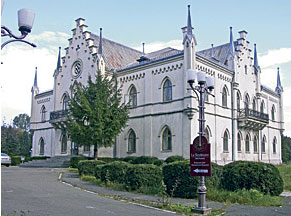 Ruginoasa Palace
Ruginoasa Palace (Palatul de la Ruginoasa)
Location: 38 miles west of Iasi
Tel: (232) 734.087
Open: Tue. - Sun. 9:00am-5:00pm; closed on Mon.
Admission charge
Ruginoasa Palace, white with gothic windows and lines, impresses its visitors today with the stories hidden within its walls, stories that point to Ruginoasa as a cursed palace in popular belief. The superstition arose following the deaths, including a suicide, in the palace of several young people. Built in neoclassic style at the beginning of the 19th century by a Moldavian treasurer, Costache Sturdza, to the design of Viennese architect Johan Freiwald, it was later rebuilt in neogothic style. The palace was best known as the summer residence of Prince, and ruler of the United Principalities, Alexandru Ioan Cuza, who bought it in 1862. His wife, Elena Cuza, made Rugionoasa Palace her permanent home and the original furniture ordered from her sketches at the renowned furniture company, Mazaroz, in Paris has been preserved and is on display in the museum. In 1982, the Palace became the Alexandru Ioan Cuza Memorial Museum in commemoration of the first ruling prince of modern Romania.
Although Alexandru Ioan Cuza died in exile, his remains were brought back to Ruginoasa and buried in the chapel. They were held here until the beginning of World War II, when the coffin was moved first to Curtea de Arges, and then to the Trei Ierarhi Church in Iasi.
The museum reconstructs the atmosphere of life on the Ruginoasa estate as it was in the 19th century: the family library with books brought from Paris; the oak desk, the gothic dining room with Sevres china and Baccarat crystal, all bearing the arms of the United Principalities, and the bedroom of Princess Elena Cuza. Amidst the beautiful gardens surrounding the palace sits a neoclassical chapel built by Sandulache Sturdza in 1811.
Moldavia is the largest wine-producing region in Romania.
Prince Stephan the Great commissioned bridges and paved roads for the transportation of wine from the Cotnari vineyards.
Grasa de Cotnari was awarded the gold medal at the 1900 World Exhibition in Paris.
Cotnari Vineyards Prince Stephan the Great commissioned bridges and paved roads for the transportation of wine from the Cotnari vineyards.
Grasa de Cotnari was awarded the gold medal at the 1900 World Exhibition in Paris.
(Podgorile Iasi)
Location: 32 miles northwest of Iasi
Tel: (232) 730.296
Email: office@cotnari.ro
Web: www.cotnari.ro
How to get here: Three daily trains from Iasi to Harlau stop at Cotnari (1 ¾ hours)
Located in the small village of Cotnari, the Cotnari vineyards are famous for their delicious sweet white wines made of grapes rich in sugar and harvested in late autumn following the first frost. The quality of these wines relies on a combination of rich soil, the late harvest and the presence of a special mold (Botritis cinerea). The winery's most popular wines include Francusa (dry), Catalina (semisweet) and the sweet, golden Grasa and Tamaioasa dessert wines. The most popular brand, "Grasa de Cotnari", is an excellent white wine often referred to as the "golden nectar."
Apart from wine-tastings, visitors can tour Cotnari's other attractions, such as cellars dating back to the time of Stephen the Great (1457-1504), where over 6 million liters of wine are being aged in oaken barrels. The winemaking plant produces 4 to 6 million bottles a year and boasts a collection of more than 800,000 bottles.
Cotnari winery offers wine-tasting sessions and tours of the cellars and factory. Every year on September 14, wine connoisseurs celebrate the harvest here.
Cucuteni
Location: 10 miles southwest of Cotnari
In 1884, Neolithic artifacts were unearthed near the small village of Cucuteni. Archaeologists named this ancient culture, which flourished ca. 4500 B.C..- 3000 B.C., after the nearby village. The Cucuteni culture is famous for its colored white, red and black ceramics which were discovered here. A collection is on display at the Moldavian History Museum in Iasi.
» Day Trips
Neamt Fortress in Targu Neamt (Cetatea Neamtului)Location: 60 miles west of Iasi
Open: Tue. - Sun. 10:00am - 6:00 pm
Admission charge
How to get here: Daily bus service from Iasi
Perched high on a rocky hill, overlooking the market town of Targu Neamt for almost six centuries, Neamt Fortress has played a vital role in the defense of the region against predatory raids. Built in the 14th century by Petru I Musat (1374-1391), it was later reinforced by Stephan the Great (1457-1504) who added another precinct with four circular towers and dug a defensive ditch which helped the fortress resist the attack of a Turkish army of 200,000 in 1476. For almost 200 years, the fortress remained invincible, until 1691 when it was besieged by the army of Ian Sobieski, King of Poland.
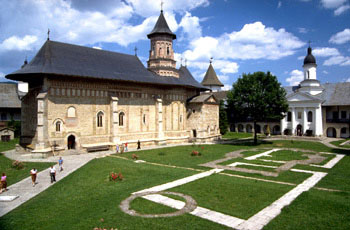 Neamt Monastery
Neamt Monastery Location: 70 miles west of Iasi (9 miles west of Targu Neamt)
How to get here: Daily bus service from Targu Neamt
Founded by Petru Musat in the 12th century, Neamt Monastery stands as one of Romania's oldest and most important religious settlements. Tucked away at the foot of the Ceahlau Mountains and surrounded by old forests, the monastery resembles a fortress with its high walls and one remaining tower (there originally were four).
The church inside the monastic complex was founded by Stephen the Great in 1497 to celebrate a victory over the Poles and represents the pinnacle of Moldavian architecture. The façade features classic Moldavian elements of the time such as gothic windows and friezes with enameled disks, colored in green, yellow and brown.
Thousands of pilgrims gather here every year to worship a 600-year-old icon of the Virgin Mary, believed to have miraculous powers.
The monastery is home to one of the oldest libraries in the country (more then 600 years old) as well as a museum illustrating the vivid cultural life that lasted here for centuries. A school of miniature painting and calligraphy was set up by monk Gavril Uric. One of the most famous manuscripts created by Uric's pupils is a 1429 parchment copy of the Four Gospels, now located in the Bodleian Library in Oxford, England. The name of the monastery comes from the Greek word agape, meaning "love." Christian scholars argue that the use of the word agapo in the New Testament refers to God's love for humanity.
Agapia Monastery is renowned for its carpet and embroidery workshops. To forego closure during the communist period, Agapia's nuns wove carpets for the dictatorship's mega-structure (now the Palace of Parliament) in Bucharest. Today, the textile workshops mainly produce carpets, wall hangings and rugs for religious purposes, but they do have commercial sales and visitors are welcome.
Agapia Monastery Agapia Monastery is renowned for its carpet and embroidery workshops. To forego closure during the communist period, Agapia's nuns wove carpets for the dictatorship's mega-structure (now the Palace of Parliament) in Bucharest. Today, the textile workshops mainly produce carpets, wall hangings and rugs for religious purposes, but they do have commercial sales and visitors are welcome.
Location: 65 miles west of Iasi (2 ½ miles south of Targu Neamt)
Hot to get here: Daily bus service from Targu Neamt and Piatra Neamt
Located in a lovely setting at the foothills of the Carpathian Mountains, this picturesque nuns' monastery (also known as Agapia in the Valley or Agapia din Vale in Romanian) was built by Hatman Gavril Coci between 1642 and 1644. However, its current neoclassical facade dates from the reconstruction period at the turn of the 19th century. The church's interior, featuring stunningly vivid portraits with eyes that seem to follow the viewer, was painted between 1858 and 1861 by the famous Romanian artist, Nicolae Grigorescu, when he was just 18.
A small museum (Open: Mon - Sun 9:00am - 5:00pm) displays 16th, 17th and 18th century painted icons, gold and silver embroidered garments, cedar and ebony crosses and old manuscripts (the library boasts some 12,000 volumes), as well as Moldavian-style carpets woven in the monastery workshops. You also can admire fragments from the original 17th century iconostasis signed by N. Grigorescu, who left his self-portrait here in the figure of Daniel, one of the saints in the upper left-hand side of the iconostasis.
The grave of Veronica Micle, the love of Romania's National Poet, Mihai Eminescu, lies within the monastery. Eminescu, best known for his 96- stanza ballad of love, Luceafarul (The Evening Star), couldn't afford to marry Veronica so poured out his grief on paper, thus, creating the masterpiece. Veronica committed suicide on August 4, 1889, two months after Eminescu's death.
Varatec Monastery Location: 68 miles west of Iasi (6 ½ miles south of Targu Neamt)
How to get here: Daily bus service from Targu Neamt
The monastery dates from 1785, when a nun, Olimpiada, laid the foundations of this monastic establishment. Set amid a lovely garden shaded by cedars, the whitewashed monastery is home to some 600 nuns today. Throughout the years, many writers, poets and scholars came here to take in the beauty of the environment, the hospitality of the nuns and villagers alike and the propitious atmosphere for rest, meditation and creative work.
Many of the nuns who entered Varatec came from noble families, bringing with them valuable art and religious objects, some of which are on display in the monastery's museum. Varatec has active carpet weaving, embroidery and icon painting workshops.
Piatra Neamt
Location: 78 miles southwest of Iasi (25 miles south of Targu Neamt)
How to get here: Daily trains and buses from Iasi
Beautifully situated in the forested foothills of the Carpathian Mountains, Piatra Neamt is another historic Moldavian town and one of Romanian's oldest settlements. The area has been inhabited since Neolithic times. In the 15th century, Stephen the Great established a princely court here. Although many of the old sections of this picturesque town were razed to the ground under the communist regime, several interesting attractions still stand. Piatra Neamt makes a nice base for exploring the Ceahlau Mountains.
- St. John the Baptist Church (Biserica Sf. Ioan Botezatorul) -
dating from 1 497-1498
- Stephen's Tower (Turnul lui Stefan) - built in 1499 during
Stephen the Great's reign
- The History Museum - housing the Cucuteni collection, the largest collection of Neolithic artifacts in southeastern Europe
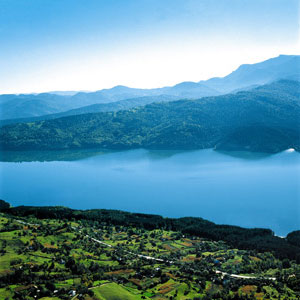 Hasmas - Bicaz Gorges National Park & Ceahlau National Park
Hasmas - Bicaz Gorges National Park & Ceahlau National Park (Cheile Bicazului & Masivul Ceahlau)
Location: 100 miles west of Iasi
How to get here: Daily bus and train service from Iasi and Piatra Neamt
The road that slices through the Bicaz Gorges (Cheile Bicazului) is among Romania's most staggering and spectacular. The gorge twists and turns steeply uphill for three miles, cutting through sheer 1,000-foot limestone cliffs on its journey through the mountains.
For hikers, kayakers and fly-fishing enthusiasts, the Hasmas - Bicaz National Park's main attraction is the Red Lake (Lacul Rosu), created in 1837 after a major natural landslide. Short and long walks provide access to the lake's spectacular scenery and many fishing spots. The Bicaz Gorges offer a unique view of the Ceahlau Massif.
Surrounded by watercourses and lakes, Ceahlau Mountain, the Olympus of Romania (it was considered to be the sacred mountain of Zalmoxis, the god of the Dacians), displays an incredible concentration of rare species and wildlife. Over 2,000 flower species, fossil limestone, the rock formations Dochia and Cusma Dorobantului, and the Duruitoarea Falls are some of the highlights of the park.
Suceava
Location: 85 miles northwest of Iasi
For more information about Suceava please visit www.RomaniaTourism.com/Suceava.html
» Performing Arts
» Opera & Ballet
Opera Romana IasiAddress: Str. Agata Barsescu 18
Tel: (232) 211.144
» Symphonic Music
Moldova Philharmonic (Filarmonica Moldova)Address: Str. Cuza Voda 29
Tel: (232) 212.509
» Theatre
National Theatre (Teatrul National "Vasile Alecsandri")Address: Str. Agata Barsescu 18
Tel: (232) 316.778
» Festivals and Events
Zilele Orasului Iasi ("The Days of Iasi" festival, held in October)CITY ESSENTIALS
» Transportation
Iasi is easily accessible from Bucharest (Bucuresti) by plane (1 hour), train (approximately 6 hours) and car (approximately 6 ½ hours).» By air
Iasi International Airport (IAS)Tel: (232) 271.570
Web: www.aeroport.ro
Airlines with service to Iasi:
Austrian Airlines - www.aua.com
Direct flights from/to: Vienna
Carpat Air - www.carpatair.ro
Direct flights from/to: Timisoara
Connecting flights (via Timisoara) from/to: Romania (Bucharest, Bacau, Cluj, Constanta, Craiova, Oradea, Sibiu, Suceava); France (Paris); Germany (Dusseldorf, Munich, Stuttgart); Greece (Athena); Hungary (Budapest); Italy (Bari, Bergamo/Milan, Bologna, Florence, Rome/Fiumicino, Venice, Verona, Torino); Republic of Moldova (Chisinau); Ukraine (Kiev, Lvov, Odessa)
Tarom - www.tarom.ro
Direct flights from/to: Romania (Bucharest, Constanta); Austria (Vienna); Germany (Frankfurt); Italy (Bologna); Spain (Madrid); Switzerland (Geneva, Zurich)
» By train
Iasi Train Station (Gara de Nord Iasi)Address: Str. Garii 1
Tel: (232) 410.636 or 215.600
There is a daily train to/from Chisinau (journey time - 7 hours).
For the list of international trains with service to/from Romania please visit:
www.RomaniaTourism.com/Transportation.html#ByTrain
There are daily trains to/from Bucharest, Oradea, Piatra Neamt, Suceava, and Timisoara as well as several other cities in Romania.
To check the latest train schedules for domestic routes please visit the website of the Romanian Railways: www.infofer.ro
The site has complete information about domestic train schedules and fares. Note: For departures from /to Bucharest please select Bucuresti Nord.
CFR's advance booking office (Agentia CFR Iasi)
Address: Str. Piata Uniri 10
Tel: (232) 242.620
Open: Mon. - Fri. 8:00am - 8:00pm; closed Sat. & Sun.
You can get train schedule information and make reservations up to 24 hours in advance at this office. Tickets for same-day travel can only be purchased at the station.
» By bus
Iasi Bus Stations (Autogari Iasi) - international & domestic serviceWeb: www.autogari.ro/localitate.php?loc=iasi&lang=
International Bus Companies serving Iasi:
Eurolines
Address: 14 Decembrie 1989, Nr. 4 bis
Tel: (232) 245.703
Web: www.eurolines.ro
Daily bus service to main cities around Europe
Atlassib
Address: Str. 14 Decembrie 1989 nr.3-5
Tel. (232) 273.040
Web: www.atlassib.ro
Daily bus service to main cities around Europe
Doublet T
Address: Piata Unirii 6
Tel: (232) 261.699
Daily bus service to main cities around Europe
» By car
The fastest route from Bucharest to Iasi is via E85- E 581:Bucharest - Urziceni - Buzau - Tecuci - Vaslui - Iasi
( map)
» Distances
| Distance from Iasi to: | |
|---|---|
| City | Distance (Miles) |
| Bucharest | 269 |
| Arad | 387 |
| Belgrade | 495 |
| Brasov | 180 |
| Budapest | 495 |
| Cluj-Napoca | 234 |
| Constanta | 260 |
| Oradea | 322 |
| Prague | 813 |
| Satu Mare | 277 |
| Sibiu | 264 |
| Sighetu Marmatiei | 170 |
| Sighisoara | 180 |
| Suceava | 85 |
| Timisoara | 415 |
| Vienna | 642 |
» Public Transportation
Several bus, tram and trolleybus routes connect Iasi's main areas and tourist attractions. The bus and trolley system is operated by R.A.T.P. Iasi.» Taxi companies
Clasic Taxi - 949 or (232) 219.589Delta Taxi - (232) 222.222
Euro Taxi - (232) 217.217
For You - (232) 222.444
Go Taxi - 944 or (232) 279.444
Lux Taxi - (232) 255.255
Parma Taxi - 941 or (232) 222.888
Pro Taxi - (232) 211.211
Taxicom - 953
Tico Taxi - (232) 272.222
» Car rental
ClivenAddress: Str. Stefan cel Mare si Sfant 8-12, Iasi
Tel: (232) 258.326
Email: office@cliven.ro
Web: www.reservation.ro
EuroCars Romania
Address: Strada Aeroport 1 (Iasi Airport)
Tel: 727 373.799
Email: office@eurocars.ro
Web: www.eurocars.ro
Promotor Services Rent a Car Iasi
Address: Str. Cuza Voda 3, Iasi
Tel: 734 403.403
Web: www.auto-rent.ro
Sixt
Address: Pacurari 15-17, Iasi
Tel: (232) 245.690
Email: email@sixt.ro
Web: www.sixt.ro
» Shopping / Antiques
www.Hardy-Antiques.ro» Accommodations
For a list of available accommodations in Iasi please check Iasi hotel guide or our Accommodations Guide.» Tourist Info
Iasi Tourist Information CentreAddress: Piata Unirii nr.12
E-mail: turism.iasi@gmail.com
Telephone: (232) 261.990
Web: www.turism-iasi.ro/index.php?id=101
» Weather
Iasi Weather Forecast - www.weather.com/outlook/travel/businesstraveler/...» Postal services & Telephone
Post offices display a postal horn symbol and the word Posta. Main Post OfficeAddress: Str. Cuza Voda 3
Tel: (232) 252.544
Web: www.posta-romana.ro
Open: Mon. - Fri. 8:00am - 7:00pm; Sat. 8:00am - 1:00pm; closed Sun.
Telephoning Iasi from Abroad
International Access Code + 40 (country code) + 232 or 332 (area code) + telephone number
» Pharmacies & Hospitals
Several pharmacies (farmacie) are open 24 hours a day in the city. Emergency Clinic Hospital (Spitalul Clinic de Urgente Iasi)Address: Str. General Berthelot 2
Tel: (232) 216.584
| Iasi - Useful Telephone Numbers | |
|---|---|
| Iasi Area Code (Prefix Iasi) | 232 or 332 |
| Ambulance (Ambulanta) | 961 |
| Police (Politia) | 955 |
| Fire Department (Pompierii) | 981 |
| Local & County Archives (Arhivele locale) | (232) 267.635 |
| City Hall (Primaria) | (232) 267.582 |
| Better Business Bureau | (232) 278.233 |
| International calls (Convorbiri internationale) | 971 |
» Maps
- City Map (Harta orasului Iasi)- Romania Maps(Harta Romaniei)
source: www.romaniatourism.com
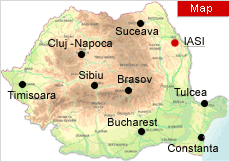






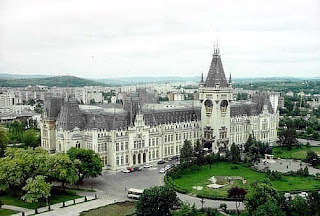

Acest comentariu a fost eliminat de autor.
RăspundețiȘtergereFoarte utile aceste informatii pe care le-ati publicat. Pentru servicii optime de inchirieri auto as mai adauga o companie in plina expansiune pe piata de inchirieri auto Bucuresti si inchirieri auto Otopeni. Firma se numeste Atlass Automotive si are cele mai bune oferte in materie de rent a car Bucuresti. Flota de masini de care dispune, contine peste 50 de modele pe care le puyteti inchiria non stop. Sediul acestei agentii se afla in imediata vecinatate a aeroportului international Henri Coanda din Otopeni. Aici clientii pot veni sa opteze pentru inchirieri auto si isi pot alege masina pe care si-o doresc din parcare. Compania aceasta de rent a car Bucuresti, va poate oferii o gama variata de masini, de la cele low cost si pana la modelele de masini din gama de lux. Daca doriti sa rezervati aveti doua variante, una ar fi cea cu deplasarea personala la sediu si cea de a doua ar fi sa rezervati direct pe site-ul de rent a car Bucuresti www.rent-a-car-otopeni.ro
RăspundețiȘtergereServicii impecabile de inchirieri auto Bucuresti in orice moment.
RăspundețiȘtergere